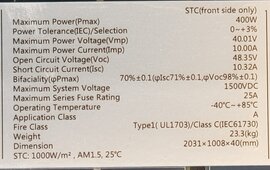bikerider4818
New Member
I have 10 X 400w (front side only) Jinko bifacial solar panels from Santan Solar. I tested each panel when I received them and they seemed okay. I'm assuming they should have a potential of 4000-5000 watts in perfect conditions, but I've never seen them produce more than about 2500w at anyone time during last summer. I have them set facing mostly south at about 29 degrees which is the optimal year round angle for my area. Today is a very gray cloudy day and they are only producing 500-700w total at noon time. Is this normal? My readings are from my 6000xp inverter.
Second question... Is there a more optimal wiring configuration I should be using? I have them setup in series with two separate arrays (5 panels each) with two seperate lines going to my inverter since it has two mppt inputs. Would it make any difference to have the two arrays joined in parallel with only one line going to the inverter (assuming the amps and volts don't exceed the mppt specs)?
Just trying to figure out why they don't seem to produce as much power as I thought they would.
Second question... Is there a more optimal wiring configuration I should be using? I have them setup in series with two separate arrays (5 panels each) with two seperate lines going to my inverter since it has two mppt inputs. Would it make any difference to have the two arrays joined in parallel with only one line going to the inverter (assuming the amps and volts don't exceed the mppt specs)?
Just trying to figure out why they don't seem to produce as much power as I thought they would.





